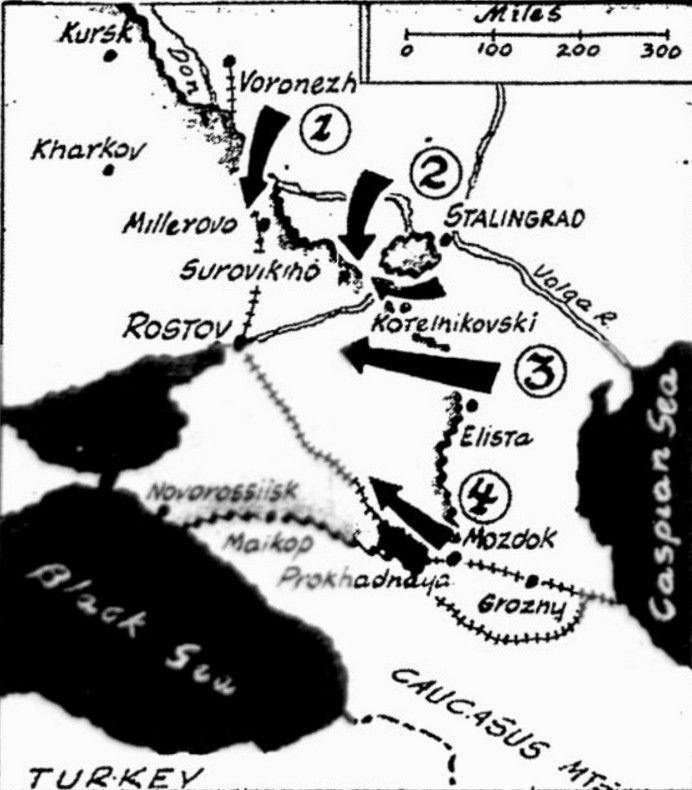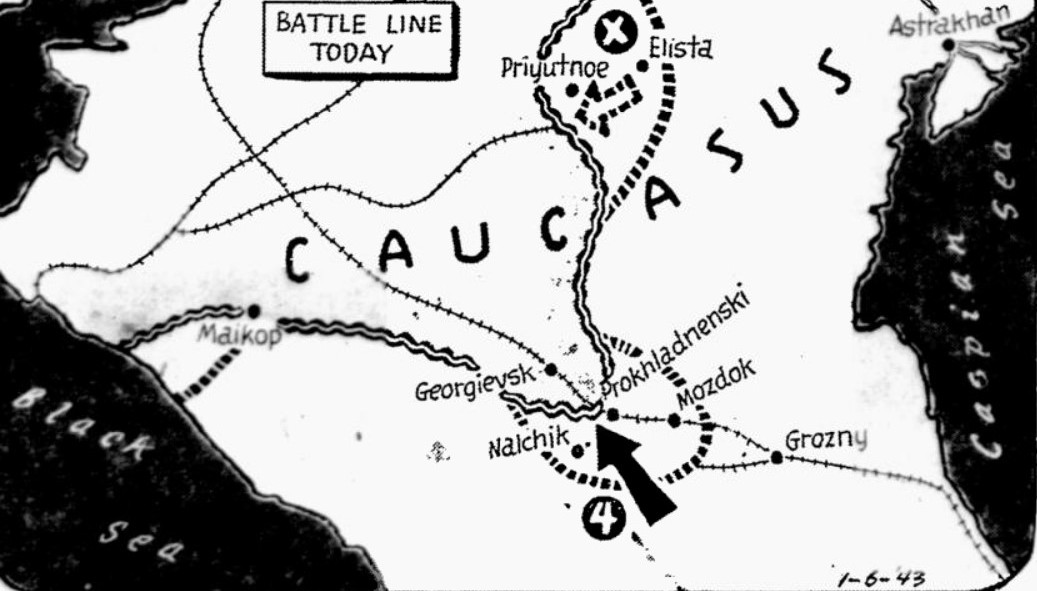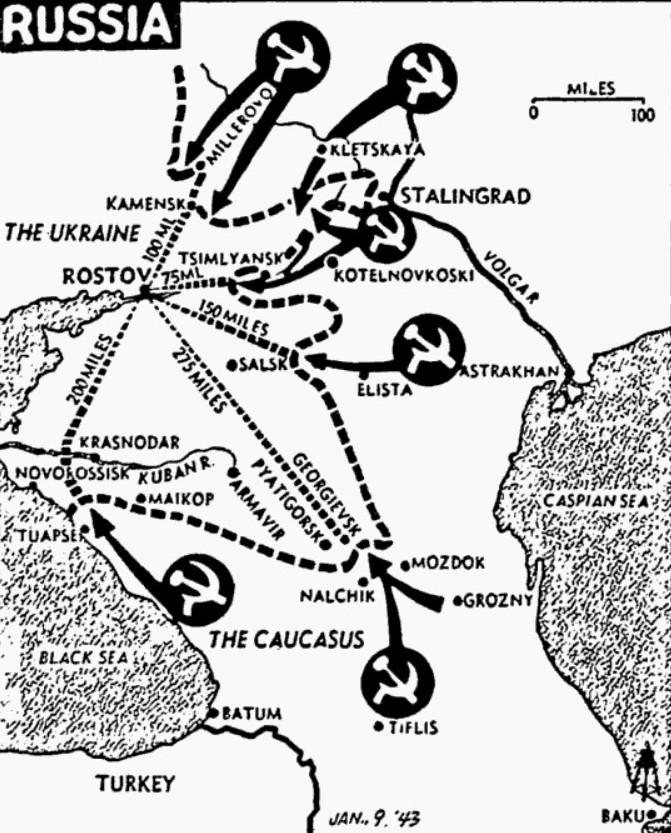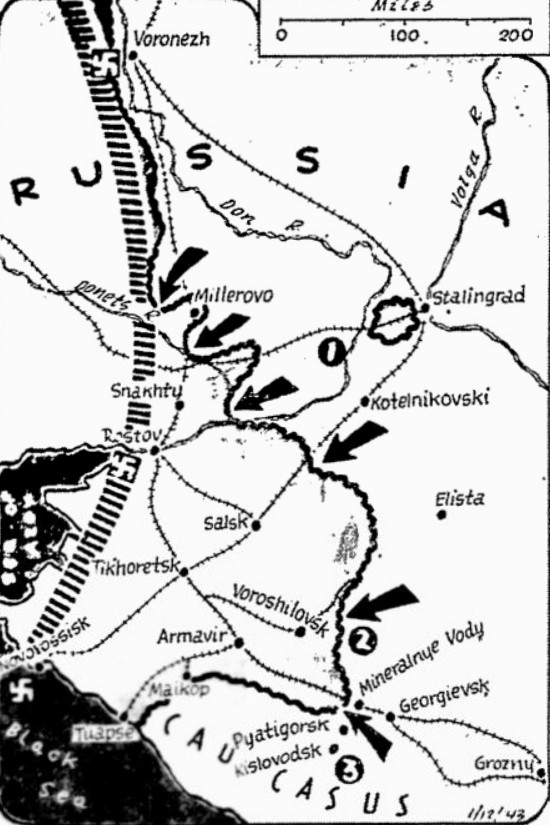The Pittsburgh Press (January 4, 1943)
NAZIS BATTERED IN CAUCASUS
Russians shatter German drive on rich oil fields
Reds close in on major Axis base on Southern Front, gain at other points
By Henry Shapiro, United Press staff writer
The Germans are retreating on a half-dozen sectors of the long Eastern Front as the Russian winter offensive rolls ahead.
1. Drive northwest of Stalingrad takes more inhabited places.
2. Reds rout foe from more positions inside Stalingrad.
3. Vast quantities of supplies captured as Nazis retreat.
4. Mozdok captured, Reds threaten to split Axis armies.
Moscow, USSR –
The Red Army, driving the Germans back from the gateway to Russia’s vast store of Caucasian oil, developed an attack from two directions today on the Axis base at Prokhadnaya, 28 miles west of Mozdok.
Front dispatches said the Russians were closing in on Prokhadnaya, a strategic rail center, and the fall of the city appeared imminent. Mozdok, threatened by the Germans for three months, fell to a lightning weekend assault by the Red Army.
Axis sources broadcast reports that the Russians were massing on the Southern Front for what was described as “a general attack.” The Nazi-controlled Radio Paris quoted German reports as saying that Axis planes were carefully watching the Russian preparations.
In taking Mozdok, their fourth major victory in six days on their 1,100-mile matter front, the Russians also took Malgobek, 20 miles to the southeast, and Elkhotovo, 40 miles to the southwest.
Nazis face general retreat
They had cut both arms of the main Rostov-Baku railroad and Russian motorized infantry and tanks were in hot pursuit of steadily retiring Axis forces.
If the Germans lost Prokhadnaya, they face the choice of a general retreat or the risk of annihilation of an army split into two sections.
The noon communiqué reported an unbroken succession of gains on six fronts from Velikiye Luki west of Moscow to the Caucasus Mountains, where the fall of Mozdok had removed, apparently for the winter if not forever, the Axis threat to the richest Caucasus oil fields.
Nazis throw in reserves
During a night of constant attack, the Russians stormed and captured several inhabited places, the noon communiqué reported.
Heavy enemy lines were reported – 700 killed within a few hours in one sector only.
Driving into one Cossack village, the Russians disabled eight enemy tanks and captured four guns and eight motortrucks.
Southwest and south of Stalingrad, where Gen. Georgy Zhukov has now joined two fronts in one gigantic offensive, the Germans were desperately throwing reserves into their lines in a vain and costly attempt to stop the Russians.
Crack troops smashed
Two full regiments (6,000 men) of Adolf Hitler’s black-uniformed SS troops, pick of the German fighting forces, were thrown into one sector last night, the Russians attacked at once and, smashing them, drover forward for new gains, the noon communiqué reported.
Village after village fell to the tanks and infantrymen before dawn today.
In Stalingrad City, the Russians sent night combat forces filtering into the German lines where they stormed and destroyed 18 blockhouses and three dugouts, the noon communiqué said.
Tanks attack alone
On the middle Don, night fighting troops captured a number of inhabited places and in two sectors, tanks, attacking alone, made important gains.
In one of these sectors, the tanks drove right through the Germans frontline, captured three villages, and sent the Germans retreating in disorder, leaving their arms and stores behind them.
In the other, the tanks killed 300 Germans and captured eight field guns and other equipment.
In the Velikiye Luki sector of the Central Front, where the Russians were now within 60 miles of Latvia after capturing Velikiye Luki itself, the Red Army advanced steadily during the night, the Germans tried one counterattack but all it got them was 400 killed.
Since last Thursday, the Russians had taken Kotelnikovsky, the greatest German base on the southwest Stalingrad Front, Velikiye Luki; Elista, capital of the Kalmyk Republic south of Stalingrad, and Mozdok in the Caucasus, for four of their most important victories of the war.
South and southwest of Stalingrad, the Axis position approached the desperate. Communiqués and dispatches of the weekend described how the German command was mainlining infantry in hopeless situations with orders to stand to the death. Transport planes were landing troops at key points. Infantrymen were thrown out in thin screens to try to stop the Russian heavy tanks and the thousands of troops following them. Little detachments were left to die at “strongpoints” in villages which the Russians took within a few hours.
Equipment captured
Thousands of Axis troops were openly retreating, and Russians tanks, racing ahead of the main forces, ripped through them with cannon and machine guns blazing.
Communiqués and dispatches continued to tell of great stores of weapons, equipment and supplies being captured.
In a single area of the Southwestern Front, the Russians captured 15 depots of stores (including nine of war equipment) one whole trainload of war equipment, a million artillery shells, 20 million cartridges, 15 tanks, 950 motor tanks and 8,000 head of cattle, the midnight communiqué said.
Food running low
German generals were deserting their troops to flee by plane. Dispatches reported that flight of one high German general in the Velikiye Luki sector and said that in the Don-Volga area where 22 German divisions, or what is left of them, are trapped, a divisional general had escaped. The plane carrying his staff crashed and 23 of the officers were killed.
A special dispatch to the army newspaper Red Star reported that the 200,000 Germans remaining of the original 300,000 in the Don-Volga trap were now getting between 100 and 150 grams (3.5 to 5.3 ounces) of bread a day and a small quantity of soup thickened by horsemeat.
German prisoners who gave this news said that nearly all horses of the cavalry among the trapped troops had been eaten now, that cases of frostbite were increasing, that deaths were taking place from under nourishment and that field hospitals were overflowing with the wounded and ill.




